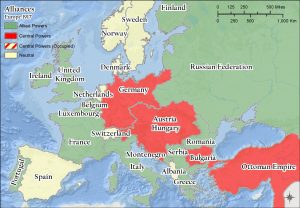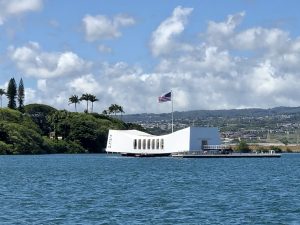52 Europe: Historical Geography I – Geography of World War II
“God created war so that Americans would learn geography.”
– Mark Twain
World War II was an enormous and complex conflict. To read all of the books that have been written about the history of the war would require a lifetime. Here, we’ll focus on the geography of the war.
In many ways, World War II was a sequel to World War I, with Britain and France once again squaring off against Germany. This time around, the two warring sides became known as the “Allies” and the “Axis.” The Axis consisted of most of Europe’s fascist powers: Germany, Italy, Hungary, Romania, and Bulgaria. (Japan was another Axis member, but that’s a story for the Geography of the Eastern World). The Soviet Union was not formally part of the Axis, but did partner with Germany early in the war. The Axis also included Austria and Czechoslovakia, which had been annexed by Germany in 1938, and Albania, which had been annexed by Italy in the spring of 1939.

The Allies initially consisted of those countries resisting fascist expansion, primarily Britain, France, and Poland. Many other countries would later be drawn to the Allied side, notably the United States and Soviet Union. A few European countries managed to remain neutral throughout the war: Portugal, Spain, Ireland, Sweden, and Switzerland. World War II was caused by multiple factors, but the primary one was the ambition of Germany’s leader, Adolph Hitler, to extend fascist control over all of Europe, and perhaps the world.

Hitler’s primary geographic strategy was to avoid a two-front war. The map above shows the European countries that were members of the “Allies” and “Central Powers” of World War I. The geography of these alliances meant that the Central Powers were essentially fighting two wars at the same time, one in the east, and one in the west. This two-front war had doomed Germany and its allies. At the dawn of World War II, Hitler firmly believed, with good reason, that no single country could defeat Germany on its own.
Germany’s first task was to secure the eastern front. In September of 1939, Germany invaded Poland. Hitler had made a secret pact with Joseph Stalin, the leader of the Soviet Union. It was an unusual partnership, considering that communism and fascism fall about as far apart on the political spectrum as possible, but Hitler was interested in defeating Poland, and Stalin assured him that he would not check German ambitions. The Soviet Union was only interested in retaking the territory it had lost in the wake of World War I. So, Germany seized western Poland, while the Soviets invaded eastern Poland, along with Latvia, Lithuania, Estonia, and Finland. With Hungary, Romania, Bulgaria, and the Soviet Union as allies, defeating Poland would secure the eastern front. With little help from Britain and France, Poland was in no position to resist the invasion by both the Germans and Soviets, and fell within a month.
Britain and France declared war on Germany in the fall of 1939, but very little happened over the winter. Many began to speak of the conflict as a “phony war.” That illusion was shattered in the spring of 1940, when Germany turned its attention to the western front. Germany crashed into France through the neutral countries of Belgium, the Netherlands, and Luxembourg. France and Britain were unprepared for both the direction and the lightning speed of the German advance. France fell in just forty-six days.
For much of the rest of the war, France was divided into three entities. The first was Occupied France, which was governed directly from Berlin. A second became known as “Vichy France.” This was territory in southern France that remained unoccupied when France surrendered. Governed out of the town of Vichy, this part of France was nominally independent, but was run by French generals who had agreed to partner with the Nazis, effectively making Vichy France a satellite state of Germany. A third element of France were the “Free French.” This force was led by Charles de Gaulle, a French general who had escaped, along with many other French officers and soldiers, to Britain. The Free French claimed to be the legitimate government of their country and, partnering with resistance fighters in France, would continue to battle the fascists throughout the war.
Germany also invaded and conquered Norway and Denmark. This left Britain as the lone allied country on the western Front. Hitler considered invading Britain, but deemed it too risky. Instead, German bombers began hammering British cities in massive night raids, while German U-boats (submarines) in the Atlantic began to cut Britain’s vital supply lines from the rest of the world. Hitler fully expected to bomb and starve Britain into surrender within a matter of months. Over the next year, the Axis moved to secure the southern front, invading British colonies in North Africa in 1940, and invading and defeating Yugoslavia and Greece in the spring of 1941. This left Britain as the only remaining Allied country. An Axis victory looked almost certain.
It was a very grim year for the Allies, but it also saw two significant turning points, both of which would ultimately doom Hitler’s ambitions. By the end of 1941, Germany found itself at war with the two countries that would later emerge as global superpowers – the United States and the Soviet Union.
Three weeks after Greece’s surrender, the Axis launched surprise attack on the Soviet Union. Looking back, we now know that this was a disastrous decision. At the time, however, it was not an outlandish idea. In 1941, few reasonable people believed that the Soviet Union could survive such an invasion. Even though it had a substantially larger population than any other European country, it did not have the industrial or military firepower equal to that of the Axis. Also, Germany had the element of surprise (legend has it that when initial reports of the invasion reached Stalin, he didn’t believe them). And, of course, Russia had an enormous geographic liability – an 1,800-mile border made up of lowlands that offered little obstacle to the Axis invaders. A defeat of the Soviet Union would eliminate any remaining threat on the eastern front, and its vast territory could serve as a warehouse of raw materials to further the German war effort. It also offered access to the Pacific Ocean, which was key to Hitler’s goal of world domination.
Another major turning point of 1941 was Japan’s surprise attack on the U.S. naval base at Pearl Harbor, Hawaii, drawing the United States into the war. This would later spell doom for the Axis, but at the time, it seemed like an early Christmas present for Hitler. The U.S. President, Franklin D. Roosevelt, had been trying to drum up support for Britain since 1939. But a large number of Americans were hesitant to get involved in the war in Europe. Now that Japan had attacked the United States, Hitler believed that Americans would forget about Europe entirely, and turn all of their attention to the war in the Pacific.
Again, Hitler’s primary goal was to avoid a two-front war. In that regard, 1943 proved to be a disastrous year. On the western front, Germany was unable to bomb and starve Britain into surrender. Also, much to Hitler’s chagrin, the United States did indeed get involved in the European war. American air crews were deployed to Britain. British bombers had been targeting Germany and its occupied territories during night raids for some time. Now, American bombers were arriving during the daytime. This “round-the-clock” bombing began to take its toll on German transportation and industry, inhibiting its ability to wage war.
More troubling for Hitler, advances on the eastern front had stalled. Germany had dramatically underestimated the resolve of the Soviets, who paid an enormous price for their resistance. The Soviet Union suffered 23 million deaths during the war, about 5 million more than every other country in Europe combined. That fact, coupled with German military blunders, a pair of brutal Russian winters, and the fact that German fighter planes on the eastern front had been recalled to defend against British and American bombers, would eventually doom the Axis on the eastern front.
Finally, another front – the southern front – opened in 1943. British, American, Canadian, and Free French forces seized control of North Africa, and invaded Italy. Germany was forced to send a significant force to northern Italy to stall the Allied advance.

Photo by James C. Garman.
1944 would bring a string of Allied advances. On the western front, Allied forces invaded France, beginning with the famous “D-Day” landings in Normandy. On the eastern front, Soviet troops pushed the Axis out of the Soviet Union, and began advancing into eastern Europe. On the southern front, Allied troops continued to advance north through Italy.
The war ended in 1945. Benito Mussolini, the fascist leader of Italy, was captured and executed on April 28, 1945. Hitler committed suicide two days later. Germany formally surrendered on May 7th. The end of the war also marked the end of the European era of global dominance. Europe’s industrial infrastructure was in ruins, and its empires in Asia and Africa began to crumble. Europe found itself divided between governments loyal to the Soviet Union, and those affiliated with the United States. The Cold War had begun.
Did You Know?
Cited and additional bibliography:
Banas, Steven. 2020a. “Europe’s Alliance in World War I.” College of DuPage GIS class. Instructor Joseph Adduci.
———. 2020b. “Europe’s Alliance in World War II.” College of DuPage GIS class. Instructor Joseph Adduci.
Garman, James C. Photo, 2023. American Cemetery at Omaha Beach in Normandy, France.
Reeder, Adam. 2019. Pearl Harbor Memorial. https://tinyurl.com/pearlmemorial. Attribution-NonCommercial 2.0 Generic (CC BY-NC 2.0).





